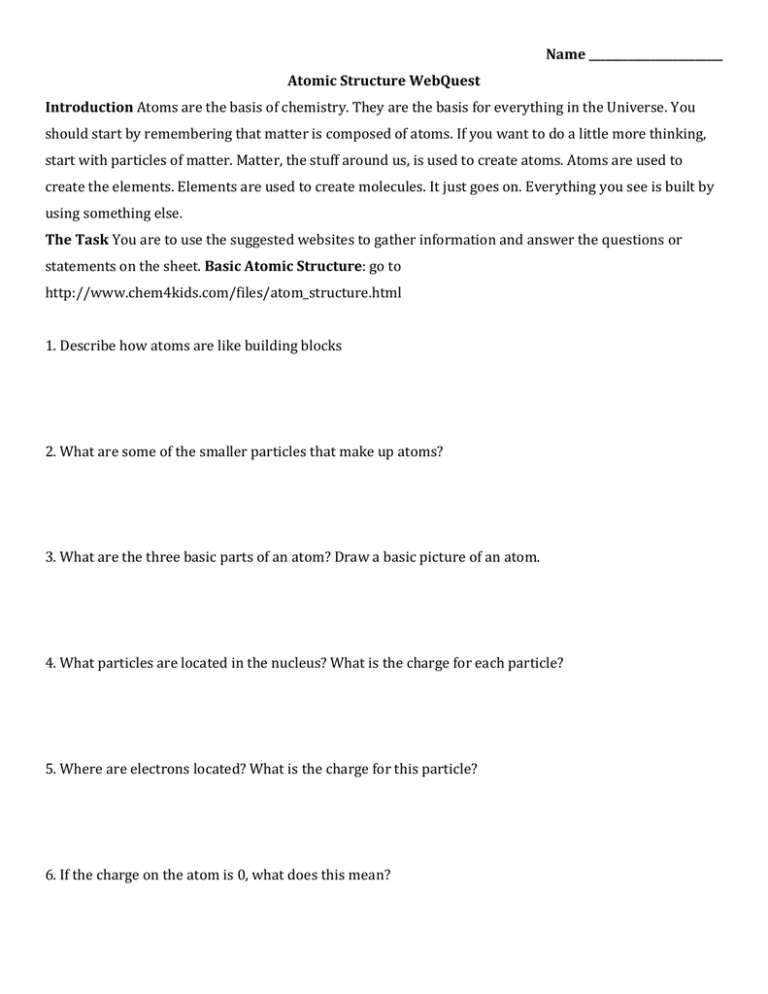Atomic Structure WebQuest Worksheet
advertisement

Name ________________________ Atomic Structure WebQuest Introduction Atoms are the basis of chemistry. They are the basis for everything in the Universe. You should start by remembering that matter is composed of atoms. If you want to do a little more thinking, start with particles of matter. Matter, the stuff around us, is used to create atoms. Atoms are used to create the elements. Elements are used to create molecules. It just goes on. Everything you see is built by using something else. The Task You are to use the suggested websites to gather information and answer the questions or statements on the sheet. Basic Atomic Structure: go to http://www.chem4kids.com/files/atom_structure.html 1. Describe how atoms are like building blocks 2. What are some of the smaller particles that make up atoms? 3. What are the three basic parts of an atom? Draw a basic picture of an atom. 4. What particles are located in the nucleus? What is the charge for each particle? 5. Where are electrons located? What is the charge for this particle? 6. If the charge on the atom is 0, what does this mean? Subatomic Particles: go to for the following http://www.qacps.k12.md.us/qhs/teachers/weedonD/atoms%20page%205.htm Nucleus: Facts: Protons: 1. Charge: 2. Facts: Neutron: 1. Charge 2. Facts: Electrons: 1. Charge: 2. Facts: Define Isotope: Give example (not from site!): Define Atomic Number: Give example (not from site!): Define Atomic Mass: Give example: (not from site!) Log on to the following website to complete the Web Quest. http://www.qacps.k12.md.us/qhs/teachers/WeedonD/Atoms%20page%202.htm 1. The basic unit of all matter is the _____________. 2. All atoms are made of three types of particles ____________, ___________, and _____________. 3. The ___________is used to identify an atom. 4. Protons are found in the ________of atoms. They have a _____charge. 5. How can you calculate the number of protons in an atom?____________________________________ 6. What happens when the number of protons in an atom changes?______________________________ 7. How big are protons compared to electrons?_______________________________________________ 8. Where are neutrons found in an atom?________________________________________________ 9. How can you calculate the number of neutrons in an atom?____________________________________ 10. How are isotopes formed?____________________________________________ 11. What is the charge on an electron?______________________ 12. How can you calculate the number of electrons in an atom?___________________________________ 13. An atom can gain or lose electrons to become an___________. 14. A sodium atom has _______ protons and____ electrons and a sodium ion would have ___________protons and ________electrons. 15. The removal of an electron results in a _____________charge. 16. THINK!! If 2 electrons were removed from magnesium, what would the charge on magnesium be?________________ 17. Electrons occupy different energy levels in the _________________around the nucleus. 18. How many electrons are found in the following energy levels: First energy level__________ Second energy level__________ Third energy level__________ Fourth energy level__________ Log on to the following website to complete the Web Quest. Step 1. Click the following link. http://www.emsb.qc.ca/laurenhill/science/models.html Step 2. Answer the following questions. 1. Scroll down to JJ Thompson’s Model of the Atom. What “name” is given his model? _________________. Draw a sketch of his model. 2. Scroll down the webpage. What are the four parts to Dalton’s Theory 3. What did Rutherford claim about the nucleus of the atom? 4. Complete this sentence about Bohr: Electrons can only occupy certain _____ _____ around the positive _______. Log on to the following website to complete the Web Quest. Step 1. Click the following link. http://www.qrg.northwestern.edu/projects/vss/docs/Propulsion/1what-is-an-atom.html Step 2. Read the top paragraph (only) and answer the following questions: 1. Everything in the universe (except energy) is made up of ______. 2. Therefore everything in the universe is made up of ______. 3. An atom itself is made up of three tiny kinds of particles called subatomic particles: _______ _________ ________ . 4. The protons and the neutrons make up the ________________ called the nucleus. 5. The _______ fly around above the nucleus in a small cloud. 6. The electrons carry a ________ charge and the protons carry a _______charge. 7. In a normal (neutral) atom the number of protons _______ the number of electrons. Log on to the following website to complete the Web Quest. Step 1. Click the following link http://education.jlab.org/atomtour Step 2. Answer the following questions 1. How many naturally occurring elements are there? ______ Click the continue button. Click the PROTON. 2. What did scientists discover in 1968? Click the NEUTRON. 3. When were they first discovered? 4. What did the scientists also learn about neutrons? Click the ELECTORNS and complete this sentence: 5. It’s easy to step off the electrons from an atom and use them to create ___ ___. Summiting your work: 1. Once you have completed your assignment save it to the Desktop of your computer File, Save As, Left Scroll Bar select Desktop, Save as: LAST NAME, FIRST INITIAL, PERIOD 2. Open you email account and email your web quest to Mrs. Reagan; Compose, To: emily.reagan@caswell.k12.nc.us There will be a paperclip in the email select it and attach your assignment to the email by selecting it off the Desktop. Subject: Atomic Structure WebQuest





